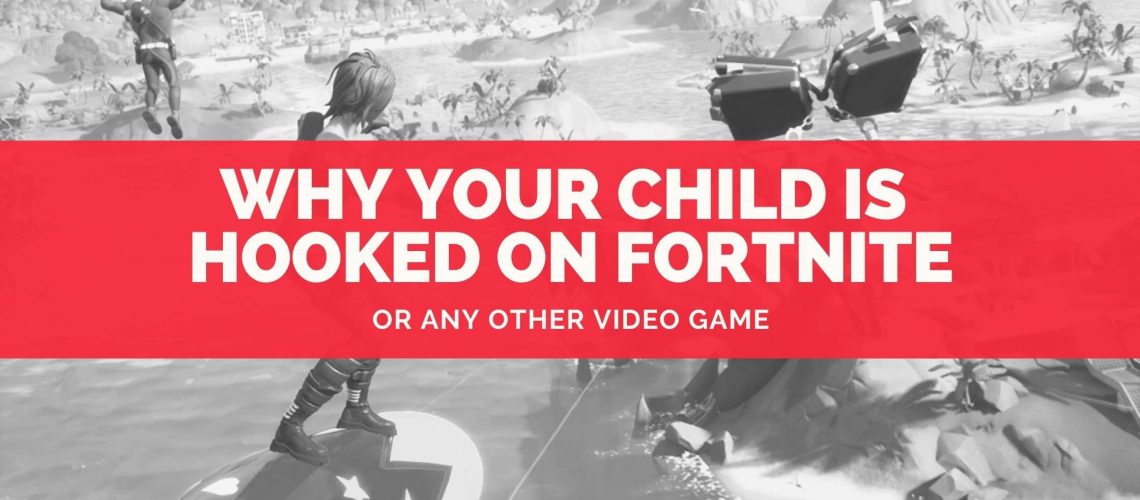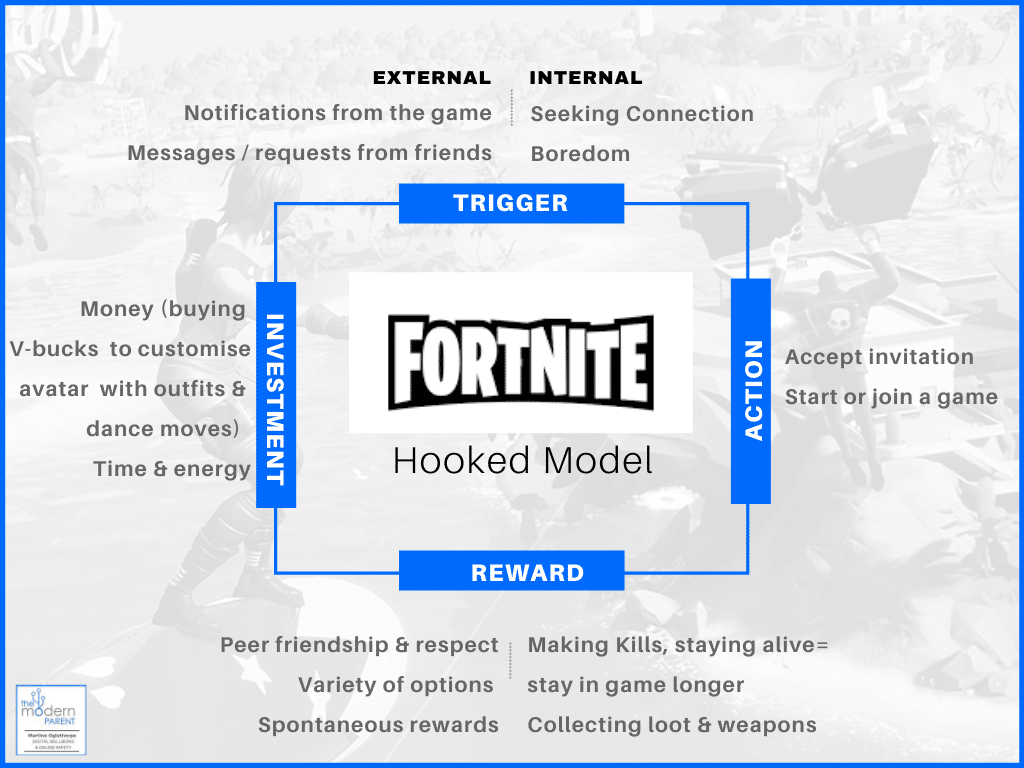Is your child hooked on Fortnite? Or any other video game, device or social network for that matter? Wondering what the appeal is and why they sometimes find it hard to get off the device?
Well their obsession is no accident and not a defect on their behalf either! Instead, it is a well thought out, research backed set of criteria that creators have employed to ensure that the game has the greatest chance of hooking in those little (and big) gamers.
Nir Eyal, author of “Hooked” and “Indistractible”, created the Hook model to show companies how to cultivate consumer habit in order to result in people’s investment. That same “Hook Model” can help us understand how game creators also use this, to ensure our young gamers are spending increasing amounts of time playing games like Fortnite, and ensuring they return time and again.
In understanding how this works, I think this can help parents see just what both they and their kids are up against when they are trying to manage their child’s game playing. But it also serves to highlight the positive aspects of playing games, and how they may in fact be used as a way to sustain a child’s wellbeing.
The Hook model involves a Trigger, an Action, a Reward and an Investment. Here’s how it works and how I have applied this model to the popular game Fortnite (you could also likely apply this to any number of games or social networks)
Triggers
We all have triggers that make us do something. These can be external triggers such as emails, notifications or calls to action or the environment in which we find ourselves. They can also be internal triggers, such as those stored in the brain as thoughts and feelings. They can be a negative emotion that needs to be ‘fixed’ or a memory of a positive emotion that needs to be repeated.
In the case of Fortnite:
Internal Triggers: boredom, loneliness and a desire to connect External Triggers: a message from a friend or notifications from the game
Action
The action is the thing we do in response to the trigger. The simpler the action is made for us, the more likely we are to take it up.
In the case of Fortnite:
The action is to simply start playing the game or respond to an invite to play. The number of ways to play makes it fairly simple in that it is available on multiple devices (PC, Switch, PS4, Xbox, phone or tablet) and it is free to play.
Rewards
The reward part of the model looks at those things we receive from the action, that satisfy the trigger and remind us why we continue to purchase or play. Rewards reinforce why we took action in the first place and leads to those actions becoming a habit. They can be internal rewards of gratification, connection, acceptance or external, such as material or monetary rewards.
In the case of Fortnite:
Rewards come about by making kills, remaining alive and thus staying in the game longer. Playing the game can lead to praise from peers and other gamers, personal gratification, connection and acceptance. Players are rewarded with new weapons and loot to help them play better. A range of variable options such as new scenes, new updates, outfits and dance moves, as well as the spontaneous rewards of the loot boxes and their unknown contents, helps to keep players engaged.
Investment
The investment is the work done or the time, money and energy invested to ensure one continues to take action, reap the rewards again and satiate those triggers.
In the case of Fortnite:
Money is invested in ‘V bucks’ allowing for the customisation of avatars with the purchase of outfits and dance moves. Battle passes can also be purchased to get ‘V bucks’, skins & pick axes. Time and energy, both physical and emotional, is also invested in playing the game.
So what does all this mean for us?
Well, if your child is loving playing Fortnite or any other computer game, it is not necessarily because they are lazy, anti-social or doing something akin to cocaine, as some experts and media would have you believe. It simply means, they are responding in a very human and scientifically proven way, to a set of criteria and mechanics, that are deliberately created to lure them in to a game, and keep them coming back.
So should we be trying to stop that cycle of hooks if we know what they are doing to us?
No, not necessarily. These marketing tactics are used extensively in our consumer society to entice us to purchase or pursue something, but not all of those purchases are necessarily bad. In fact, many can be a very positive addition. So unless the outcomes of the game playing are proving harmful or having a negative impact on other aspects of our lives, then it is probably going to be ok, or even helpful.
It does remind us however of the need to maintain some boundaries, especially when children are young, so those ‘hooks’ don’t get in too deep and one no longer has any control.
So knowing what our kids are up against, here are a few things we can think about to help maintain that control and ensure that their gaming remains a positive way to spend their time….
- Be sure that the game they are playing is appropriate. If you are not sure, watch someone playing it on youtube and you will soon get a good idea. Alternatively you can have a game yourself in order to decipher whether it is something your child is developmentally ready for.
- Make sure younger kids are not talking to people they don’t know or are not getting exposed to explicit language, abuse or bullying. Got to the privacy settings and make the necessary changes to ensure they remain safe and their wellbeing is a priority.
- Look at the effects of gaming on your individual child. How is their mood affected whilst playing? Are they different after playing or particularly agitated when they are unable to play? A few short outbursts at the screen may be ok, but if this is making them become overly aggressive, affecting their relationships or having a negative impact on the other aspects of their lives, then you may need to make some changes.
- Play with them occasionally to get a better understanding of the games, but also to have greater impact and relevance when explaining why you may need to have some rules and boundaries. It can also be a great way to bond with your child (and from my own experience they get quite a thrill out of being much better than you at something!)
- Talk to them about how these games hook us in and hence the need to maintain balance and control so they know you have reasons for rules and are not just trying to take away their fun. When talking about those boundaries, have these conversations away from the game, not whilst they are mid battle!
- Be realistic about their need to connect with friends, especially if they are in some form of Covid lockdown or if other activities are on hold. For many kids right now, it is not so much the game that is crucial, but the connections, the tonic to loneliness and the stress release the game provides, that may be the greatest driver for their desire to play.
Whilst the games may change, the ways in which the hook model is employed by so many companies, creators and marketers, will ensure these tactics continue to play a role in much of what we consume and in many of the ways we spend our time. And we can be ok with that, as long as we maintain focus on positive experiences and outcomes and by doing what we can, to ensure the wellbeing of our kids remains a priority.
For more ways to help ourselves and our kids remain in control of their online behaviours, you can grab a copy of my latest book The Modern Parent: Raising a Great Kid in the Digital World”. Available as a hard copy paperback or as a PDF.



